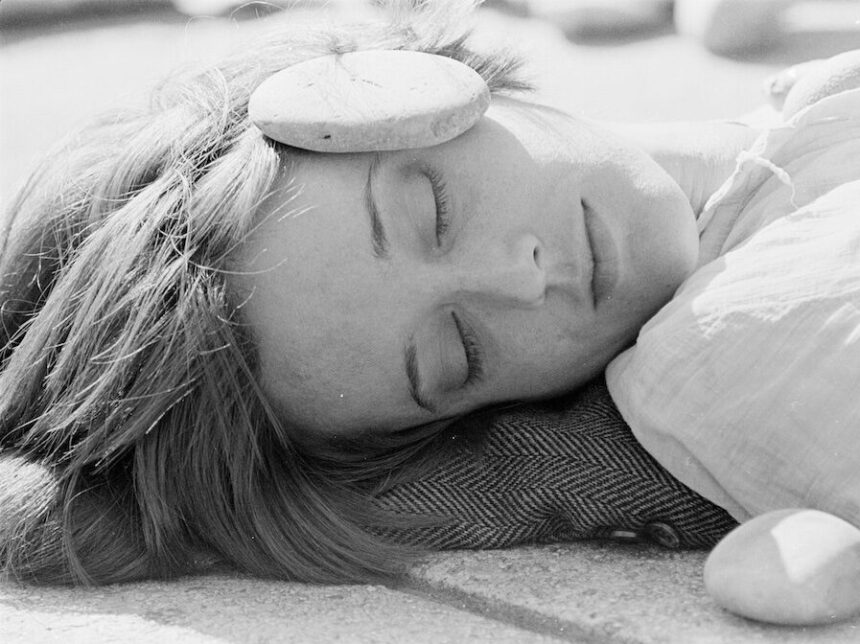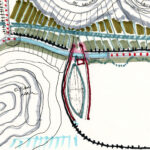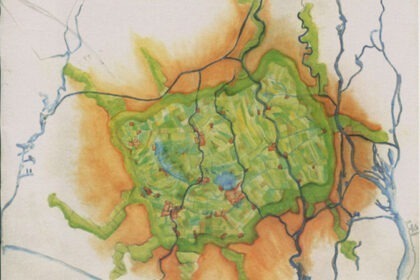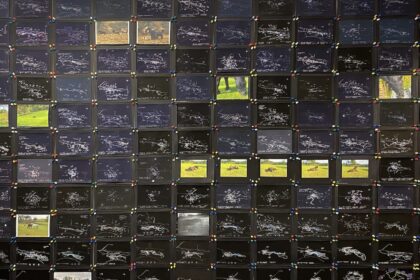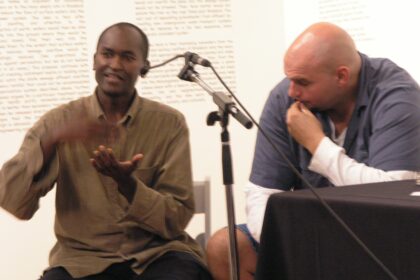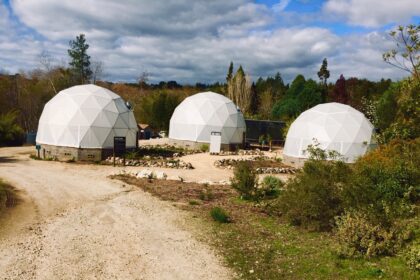Helen and Newton Harrison
Betsy Damon
This is primarily about the relationship I had with the Harrisons, and the particular ways that we interacted with and assisted each other. Possibly the deepest connections we had were invisible and unarticulated. Right in the beginning, we discovered that our processes were similar. We let the earth, the land, and waters reveal their hidden and unhidden stories. We both worked with maps to find our pathways. I was on my own similar process of putting maps on my studio walls or walking sites over and over again. I listened and considered following what I heard, even though I did not always know what to do. This relationship allowed me to believe more in myself. The Harrisons communicated a confidence in me, which I kept close to my heart and was invaluable.
I’ve known Newton and Helen since the 1980s, when we were in several pioneering eco-art exhibitions. We immediately gravitated towards each other as kindred spirits in this new art form, a form which held the wellbeing of earth at the center. Sparks started flying as we shared our interests in engaging with ecosystems. All our meetings included an enjoyment of life; food and discussions were richly paired as we easily exchanged our ideas. What greater pleasure is there than to share ideas over iced tea or coffee outdoors in southern California, with two people who love to think? The magnitude of their generosity cannot be overstated. There was no such thing as “we have an hour” or “we only have a few minutes”—we had time and space to expand.
By his own admission, Newton led a charmed life. He was a successful teenage artist. He started at Yale, where he got mad at Josef Albers’ criticism, wanted to leave, but stayed and later understood the significance of Albers’ teachings. In Newton’s words, the University of California San Diego (UCSD) provided him with everything he needed to grow and develop his ideas: a large studio and good budget. I confess to feelings of jealousy.
Helen held an administration position at UCSD. After having four children, around age 40 she joined Newton in his quest to work with and for the earth. Thus, began a rare partnership. Helen became more than the voice of every project. With her grounded sensibility, she evolved the projects with Newton. Her writings wove together ideas, invisible energies, history, science, and deep knowledge of a site. She was level, kind, and generous. Newton’s love and respect for her was ever-present. She was the person who wove everything together and cooked the meals. Together they brought forth comprehensive approaches and innovations.
Rarely have I met a person with the strength of confidence that Newton possessed, which was matched by a confident partner whose strength was to augment and bring together the ingredients creatively. Regardless of any success or failure, they set out to understand. They relocated a meadow to a terrace at the museum (for me a questionable idea), but then they replaced the meadow and gave seeds to the farmers; this idea led to a vast education. They ask what worked, and what could be better. Their biggest success was in the Netherlands, where the scale of the country matched their capacity, whereas the Salvo River projects encountered more obstacles. But every effort was a pathway towards more information.
As a single parent of two, I was too busy with my life and career to stay closely in touch. I visited Helen and Newton in southern California and visited the spot where they brought runoff to the beach, and the island they created from collected debris behind a dam. As one who was very aware of the difficulties of creating interventions in a highly engineered system, all these works seemed like attempts to address issues in their community, which I later learned was very difficult.
Newton rarely praised anyone, and told me as much. He was uncompromising, always straightforward and generous. He could ask for what he needed, and was usually unwilling to compromise. He told me humorous stories of walking away from funders who “pissed him off”.
In 1989, we were invited to submit work to the São Paulo Biennial with artist Suvan Geer. It was quite a day of brainstorming. Newton and I wanted to address the reality that São Paulo had some of the worst air pollution in the world. We came up with an idea to make a room in which the air was as pure as possible—as pure as it was thousands of years ago. If a person remained in the room long enough, their lungs would begin to heal. I cannot remember the exact details, except the budget was $250,000. We could create the room for around $100,000, and we decided that the rest of the budget should go to a hospital that treated lung diseases. Suvan was tactfully quiet. Helen, who sat calmly in a reclining chair as we talked, pragmatically pointed out that we weren’t very likely to receive the commission for doing this. Although she was right, this did not stop us from proposing the idea.
We stayed in touch over the years. I would drop in to see them in Santa Cruz if I was in San Francisco, and visit them whenever they exhibited at the Feldman Gallery in New York. Newton was always expanding and loved to crunch numbers. One of their last projects was a large-scale response to climate change, called Glacial Gardens. They developed the idea of mapping how vegetation moves to higher elevations as the earth warms. They pioneered this idea in the UK, where it was well received. Practical as always, Newton developed a plan to model which plants would climb to higher elevations and created a site in California where he could study the plants. Newton wanted to start five models in different geographies, with one in China. He applied this concept to the Himalayas. He told me proudly that he had figured it all out, and had written to the Dalai Lama. I resisted a chuckle—I doubted that he understood the terrain of the Himalayan Mountains, that they are made up of shale and are extremely steep after 14-15,000 feet. My son is a mountain climber in Western China. I have spent time at an elevation of 15,000 feet. Nevertheless, I was familiar with Chinese mountain experts who had knowledge of plants and vegetation at high altitudes and I resolved to introduce Newton to Tang Ya. I did not mention how difficult it is to start anything in China. Everything is first modeled and must pass approval by a science institute. My successes in China were built on relationships I formed over time and depended on me living there.
I introduced Newton to Tang Ya, one of the foremost mountain experts in China. Tang Ya, a warm-hearted man, agreed to visit the Harrisons in 2016. I flew out to California to be with them for a few days. He took Tang Ya to the test site not far from Santa Cruz. Tang Ya was impressed, and together they hatched a plan for Newton to visit China. Newton and I took morning walks where he let me know his deeper feelings about losing Helen and his dedication to her. Helen was already declining, but she was still pithy and somewhat present. We went out to a delightful lunch where she and I could talk as women about our lives and marriage.
Newton flew to Chengdu in September 2016 with an assistant. This was a very difficult trip for him, but he never complained. Tang Ya and Newton visited a site that was at the right elevation, above 7,000 feet, and was easily accessible from Chengdu, so that Tang Ya’s students could do the research. After Chengdu, he came to Changshu, near Shanghai for the INTECOL International Wetlands Conference, where I was one of the keynote speakers. I was able to arrange for Newton to present his ideas at the workshop.
Six months later, Newton learned that the site was no longer available. Land in China is carefully managed and rarely available to foreigners for an experiment. Regardless, these “starts” expanded the thinking for those who were helping make this idea a reality.
Newton and Helen’s path was unique. They dove headfirst into ecologies. Robert Smithson, Michael Heizer and Christo and Jeanne-Claude come to mind as Newton’s peers. Their work is about their footprints on nature. But the Harrisons pioneered work for and with the earth, beginning with building a fish farm in a gallery in 1971. They were on an adventure rooted in a moral imperative—love life on this earth. Their ideas often challenged the status quo and the very concept of art. They created gallery installations out of graphics and maps; but I often wondered about the real impact of these installations, which were presented to the art world bubble. The heart of their work unfolded on site, in offices, and in discussions with governments. They considered the impact of their work on ecologies and species, modeling flexibility and complexity in the process. Their work is much different from “earth” art as it considers and reveals the complexity of the living system. The work of Smithson, Heizer, Christo and Jeanne-Claude, and many others had little to do with thinking about what would really benefit the living system upon which all species depend.
Digging up and transplanting a large meadow to exhibit at a museum was questionable—why? It opened up the museum to what can be “art” and focused a lens on the meadows. But they did not leave it at that. After they realized what had happened after removing a meadow, they recreated it. They gave seeds to the local residents, expanding consciousness around meadows.
One of their most successful works was A Vision for the Green Heart of Holland, a multi-dimensional mapping collaboration with experts and government. It resulted in a comprehensive mapping of the Netherlands, which the Dutch government began to seriously consider as a master plan for developing the country. It included how much green space could support the population and where growth could be located while keeping a central vast green heart. During the project the government changed and the concept was shelved, but today, the Netherlands is returning to this idea. What if every city calculated how many trees it needed for people to breathe well? What if artists and visionaries could model their artistic practice on earth’s complexity?
Our projects paralleled each other. Mine in Chengdu, China and theirs in the Netherlands. As Newton would say, they were similar but the scales were different. Similarly, these projects are being brought forward now as solutions in the present. Over more than 40 years we were connected by energies far larger than ourselves. It is not an accident that both of our biggest successes were outside the US.
Newton and Helen invited us to think about the vast interconnectedness of earth’s living systems because this interconnectedness is what they discovered through their efforts. Everyone was welcome at their table, initiating an interconnected group of earth workers. Their practice, along with many others, became a major change agent in a narrow art world. They did not simply think about the place, but considered the people who lived there and the ecosystems they depended on. How much clean air would a person need to repair their lungs? How many mangroves do we need to clean up the oceans? What if every country mapped their coastal areas, then restored their wetlands to restore the oceans? Now that is ART!!
After an immense and long practice, I like to think of Helen and Newton cheering us all on.
Betsy Damon is an internationally recognized artists whose work with water, site-specific sculptures and performance has received widespread acclaim and publication. Since 1985, Damon has focused on water and ecological issues. She created the Living Water Garden in Sichuan, China – a six-acre urban park that has become an icon of natural water cleaning systems. She is the founder of the nonprofit Keepers of the Waters, through which she promotes environmental education, ecological planning, community projects and advocacy worldwide. In 2022 she published the book Water Talks: Empowering Communities to Know, Preserve and Restore Their Waters (Steiner Books).

